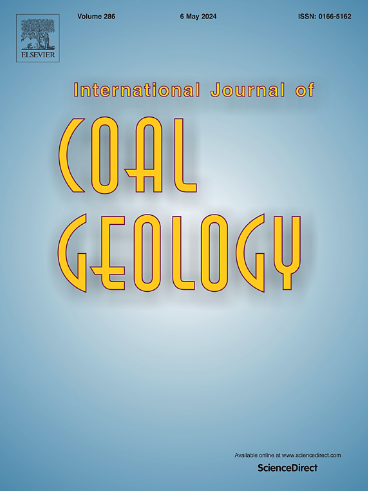Modes of occurrence of rare earth elements and yttrium in the subbituminous coal of the Jungar Coalfield, Ordos Basin, North China
IF 5.7
2区 工程技术
Q2 ENERGY & FUELS
引用次数: 0
Abstract
Modes of occurrence of rare earth elements (REE; if including Y, REY) in coal have attracted much attention owing to the extraction potential of REY from coal fly ash. Although previous studies have explored the associations of REY in coals with different ranks and the affinities of light, medium, and heavy REY associated with organic matter, challenges remain due to the limitations of indirect or in-situ analytical techniques. This study focused on the in-situ distribution of REY in the selected subbituminous coals from the Jungar Coalfield as well as in their associated mudstone and tonstein partings and the widely distributed calcite veins inside the coal seam, using LA-ICP-MS spot and mapping analysis. The results showed that in the subbituminous coal, La and Ce as well as other light REY (LREY) are concentrated in the minerals such as bastnasite and monazite. Small amounts of Pr, Nd, and Sm can be associated with organic matter including vitrinite and liptinite. Medium REY (MREY) and heavy REY (HREY) are highly enriched in vitrinite in the subbituminous coal. In terrigenous mudstone of the subbituminous coal, La and Ce are concentrated in monazite. Other LREY are present in Ti-oxides, while HREY tend to occur in zircon. MREY can be associated with both Ti-oxides and zircon. The calcite veins in the coal seam are classified into three types based on their morphology and occurrence features: bedding calcite veins in the upper part of the coal, vertical calcite veins in the middle, and vertical calcite veins with a high Sr value in the lower part of the coal. Polarization and crystal size of calcite crystals in these veins exhibit multistage growth. LA-ICP-MS spot analysis shows that the bedding and vertical calcite veins are characterized by positive Y and Gd anomalies, suggesting their formation under meteoric water leaching. The vertical calcite vein in the lower part of the coal seam displays a positive Gd anomaly and high Sr concentrations, indicating formation under seawater injection. The concentration of REY in all epigenetic calcite veins increases with depth. For calcite veins with multi-stage growth, the REY content in the late-stage calcite is consistently higher than in the early stages. It is proposed that leaching of meteoric water and seawater on the coal seams is the key factor for the association of REY with organic matter, influenced by the chemical composition and pH value of the leaching fluids. In particular, MREY and HREY are preferentially associated with organic matter, mainly vitrinite, and the over-leached MREY and HREY in coal were concentrated in epigenetic minerals, with calcite being the primary phase in this study.
鄂尔多斯盆地准噶尔煤田亚烟煤中稀土元素和钇的赋存方式
稀土元素的赋存模式由于REY从粉煤灰中提取的潜力,在煤中含有Y、REY)受到了广泛的关注。虽然以前的研究已经探索了不同等级煤中REY的关联以及与有机质相关的轻、中、重REY的亲和关系,但由于间接或原位分析技术的局限性,仍然存在挑战。利用LA-ICP-MS斑点和填图分析,对准噶尔煤田选取的亚烟煤及其伴生泥岩、灰岩分体和煤层内广泛分布的方解石脉进行了REY的原位分布研究。结果表明:在亚烟煤中,La和Ce以及其他轻REY (LREY)主要富集在氟碳铈矿和独居石等矿物中;微量的Pr、Nd、Sm与镜质组、脂质组等有机质有关。在亚烟煤中,中效REY (MREY)和重效REY (HREY)的镜质组富集程度较高。在亚烟煤的陆源泥岩中,La、Ce富集在独居石中。其他轻稀土元素存在于钛氧化物中,而重稀土元素则倾向于出现在锆石中。MREY可与钛氧化物和锆石伴生。根据其形态和赋存特征,将煤层中的方解石脉划分为三种类型:上部为顺层方解石脉,中部为垂直方解石脉,下部为高Sr值垂直方解石脉。方解石晶体的极化和晶粒尺寸表现为多阶段生长。LA-ICP-MS斑点分析表明,层理和垂直方解石脉具有正Y和正Gd异常特征,表明它们是在大气降水淋滤下形成的。煤层下部垂直方解石脉呈正Gd异常,Sr浓度高,为海水注入下形成。REY在所有后生方解石脉中的浓度随深度增加而增加。对于多阶段生长的方解石脉,晚期方解石的REY含量始终高于早期。认为大气降水和海水对煤层的浸出作用是REY与有机质结合的关键因素,浸出液的化学成分和pH值对其影响较大。其中,MREY和HREY优先与有机质伴生,以镜质组为主,煤中过浸的MREY和HREY主要富集于后生矿物,方解石为本研究的主要相。
本文章由计算机程序翻译,如有差异,请以英文原文为准。
求助全文
约1分钟内获得全文
求助全文
来源期刊

International Journal of Coal Geology
工程技术-地球科学综合
CiteScore
11.00
自引率
14.30%
发文量
145
审稿时长
38 days
期刊介绍:
The International Journal of Coal Geology deals with fundamental and applied aspects of the geology and petrology of coal, oil/gas source rocks and shale gas resources. The journal aims to advance the exploration, exploitation and utilization of these resources, and to stimulate environmental awareness as well as advancement of engineering for effective resource management.
 求助内容:
求助内容: 应助结果提醒方式:
应助结果提醒方式:


